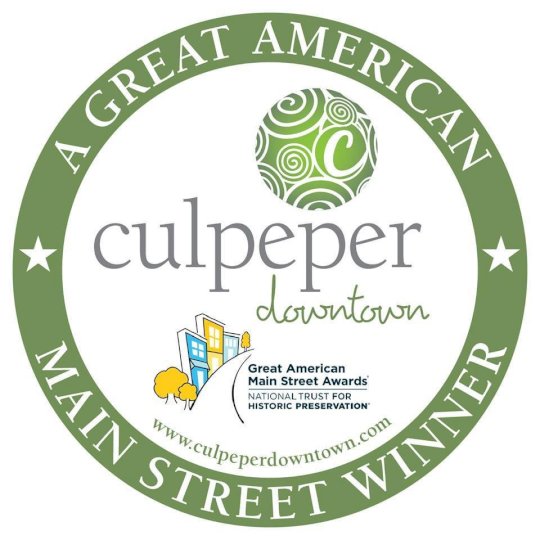

Who We Are
Vision Culpeper Renaissance, Inc.’s Vision for Culpeper is a connected, adaptive and distinctive downtown that is inviting and attractive to multiple generations of entrepreneurs, residents and visitors. Mission The purpose of Culpeper Renaissance, Inc. is to ensure a growing and stable commercial center in downtown Culpeper by: Increasing use of Downtown by Locals and Visitors Improving District Identities Promoting an Eclectic Business Mix And, Strengthening a Unified and Enduring Sense of Place History Following two centuries as a profitable, working downtown, historic Davis Street in Culpeper, VA, fell into a state of decline. Contributing factors included the construction of a bypass and shopping centers on the North and South ends of town. What was once the main center of town now had abandoned buildings with trees growing through the roofs, and by the late 1970’s, crime and neglect were rampant. The catalyst for a citizen-led preservation effort occurred when Norfolk Southern Railroad Company considered demolishing the once bustling train depot. In 1987, to prevent a potential collapse of downtown buildings, a group of concerned citizens formed Culpeper Renaissance, Inc. (CRI) to initiate a systematic approach to revitalization. At this time, CRI became Virginia’s first Virginia Certified Local Government Program for the Department of Landmarks; and the Town of Culpeper and CRI began a concerted effort to restore the heart of the town by establishing a Historic District and having Davis Street listed in the National Register of Historic Places. This designation allowed the Town to regulate sensitive restoration of Davis Street. Through partnerships with town and state government, and other private and public entities, a $4,000,000 bond was issued to initiate restoration of the downtown. In 1988, CRI’s charter members researched and saw the practicality of the four point application of the Main Street approach, and in 1988, CRI joined the newly formed Virginia Main Street Program. CRI and the Town worked closely with property owners to encourage reinvestment by providing matching grants and loans through the VMS Revitalization Block Grant Program. In 1988-89, with funding assistance from the Virginia Main Street Program, telephone poles came down, wires were buried, sidewalks added, and decorative period lamps were installed along historic Davis Street. In 1999, the Town received a grant from the Virginia Department of Housing and Community Development to preserve the train depot, providing an anchor for future downtown restoration. The excitement generated by the rebirth of the ‘Depot’ led to private sector investment. When author Norman Crampton recognized these partnership efforts by naming Culpeper “One of America’s 10 Best Small Towns”, our future was once again bright. The downtown survived the decay and blight to re-emerge as a vibrant, eclectic destination for residents and visitors alike. CRI has collaborated with private stakeholders, the Town of Culpeper, and VMS for over 30 years on revitalization efforts to make the downtown a vibrant jewel of the community. With the four point strategies approach as exemplified by the VMS program, the legacy of the success of historic Davis Street continues as the renaissance of Main Street begins. Buildings along Main Street are currently being restored with the same entrepreneurial spirit which guided those original efforts. CRI’s continual alliances have enabled Culpeper to capitalize on our rich past and look forward to our sound future.
What We Do
Culpeper Renaissance, Inc. (CRI), is a 501c3 charitable organization charged with supporting the growth and revitalization of Culpeper’s historic commercial district, the downtown. Culpeper is a Designated Virginia Min Street Community and CRI is the organization designated by the state and the Town of Culpeper to carry out the Main Street activities. The Four Point Approach While many of the states participating with statewide programs are vastly different form others and even within a state like Virginia, there are designated Virginia Main Street communities that range from 1000 – 65,000 in population, all the successful Main Street communities have two things in common. They all have a dedicated volunteer corps and they follow the Main Street Four Point Approach that was developed through several years in several communities as the framework for successful revitalization. The Four Points are the true heart of the success of the Main Street movement and meant to be used in approximately equal measure. They are: Design, Organization, Promotion and Economic Restructuring. Below, you will find a brief overview of these points and the activities our organization manages under each point. Four Points Committee Description - Design – Improving the physical environment by renovating buildings, constructing compatible new ones, improving signs and merchandise displays, creating attractive and usable public spaces, and ensuing that planning and zoning regulations support Main Street revitalization. Project/Program Examples: Hanging Baskets Beautification of Alleys Banners Holiday Décor Façade Grants Façade Design Renderings Façade, Sign, or Awning Grant Program E.B. Wood Community Park Culpeper Downtown Mural Program Organization – Building collaboration among a broad range of public- and private-sector groups, organizations, and constituencies. Project/Program Examples: Volunteer Recruitment Fundraising Projects Public Outreach Trainings (board and staff)) Partnering Entity Relationships Promotion – Marketing the district’s assets to residents, visitors, investors, and others through special events, retail promotion, and activities that improve the way the district is perceived. Project/Event Examples: 3rd Thursday Concerts Culpeper Block Party; Hop N Hog 4th of July Car & Bike Show Holiday Open House Culpeper Downtown Farmers Market Gnarly Hops & Barley Fest Destination Downtown Culpeper Publication Social Media Economic Restructuring – Strengthening the district’s existing economic base while finding ways to expand it to meet new opportunities – and challenges from outlying development Project/Program Examples: Available Retail Listing Property and owner listing Business Openings/Closings/Relocations Ribbon Cutting Events Zip Code Survey Program Mystery Shopper Program Business and Property Owner Trainings Market Analysis


